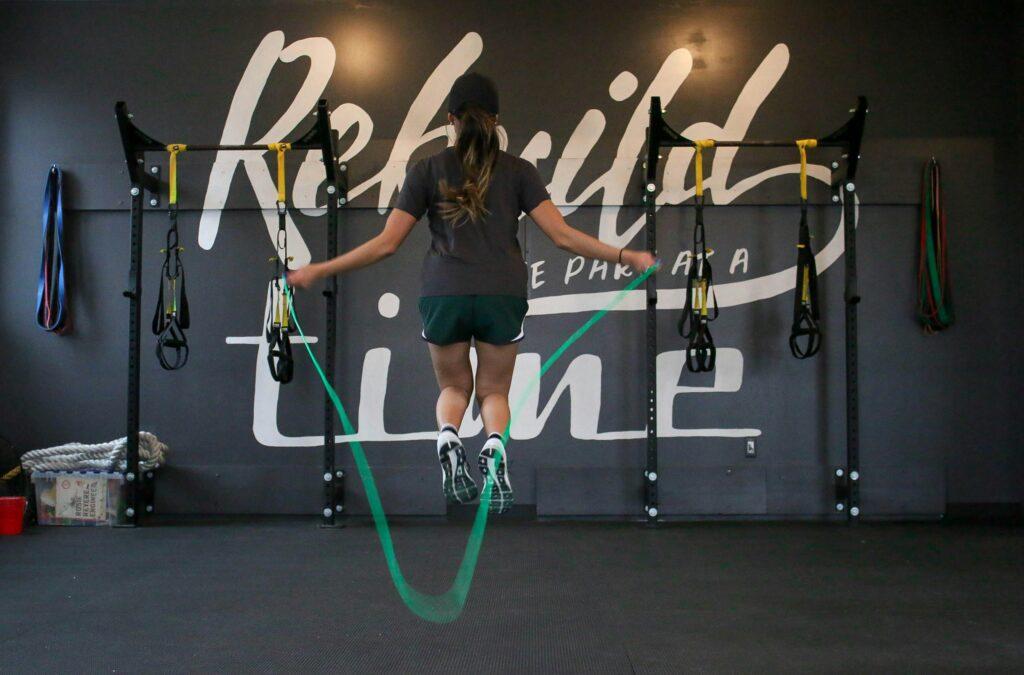Jump rope is not just child’s play – it’s a dynamic and effective workout tool that can help you achieve your fitness goals. Whether you’re looking to improve your cardiovascular fitness, burn calories, or enhance your coordination, incorporating jump rope into your workout routine can take your fitness to the next level.
But where do you start? In this article, we’ll guide you through some jump rope tips and provide tips to help you maximize your workout. From jump rope sizing to mastering jumping technique and exploring footwork variations, we’ll cover it all. So grab your jump rope and get ready to jump into a more challenging and rewarding workout routine.
Key Tips for Jump Ropes:
- Mastering jump rope basics can help improve cardiovascular fitness and burn calories.
- Sizing your jump rope correctly is crucial for efficient and comfortable jumping.
- Proper jumping technique includes maintaining proper posture and focusing on wrist movement.
- Exploring footwork variations can add variety to your workouts and target different muscle groups.
- Jump rope offers a fun and challenging way to elevate your cardio game and achieve your fitness goals.
Sizing Your Jump Rope: Finding the Perfect Fit
Finding the right jump rope size is essential for efficient and comfortable jumping. To determine the perfect fit, follow these simple steps:
- Stand on the center of the rope with your feet together.
- Bring the handles of the jump rope up to your chest.
- Adjust the length of the rope until the tops of the handles hit the middle of your sternum.
By ensuring the jump rope is the correct length, you can optimize your jumping performance and prevent any discomfort or frustration during your workout.
When considering jump rope sizing, keep in mind that using a rope that is too long or too short can negatively impact your jumping technique and overall experience. A rope that is too long may hit the ground frequently, causing unnecessary interruptions in your rhythm. On the other hand, a rope that is too short may force you to hunch over or limit your range of motion.
In addition to length, there are other factors to consider when choosing the perfect jump rope:
- Weight: The weight of the rope can affect the intensity of your workout. Lighter ropes are ideal for speed and agility training, while heavier ropes provide more resistance for strength and endurance.
- Snap: A jump rope with good snap allows for smooth rotations and minimal drag, enhancing your jumping experience.
- Construction: Jump ropes are typically made of materials like PVC, leather, or steel cable. Each has its own benefits and considerations, such as durability and flexibility.
- Adjustability: Some jump ropes have adjustable lengths, allowing you to customize the size to fit your preferences.
- Handles: Comfortable handles with grip are essential for a secure and enjoyable jumping experience.
By taking these factors into account, you can select a jump rope that not only fits you perfectly but also meets your specific workout goals and preferences.
Now that you know how to size your jump rope and what to consider when choosing the perfect fit, you’re ready to take your jump rope workouts to the next level. In the next section, we’ll delve into mastering jumping technique, ensuring you have the skills to maximize your workout effectiveness.
Mastering Jumping Technique: From Beginner to Advanced
Proper jumping technique is crucial for efficient and effective jump rope workouts. By mastering the fundamentals, you can improve your jump rope form, maintain proper jumping posture, and avoid common mistakes like the double bounce. Follow these tips to take your jump rope skills to the next level:
1. Position Yourself Correctly
To start, position yourself with the rope behind your heels. Keep your palms facing forward and your elbows close to your sides. This posture sets you up for a successful jump and helps maintain stability throughout your workout.
2. Initiate the Jump
Swing the rope over your head and aim to bring it just in front of your toes. Focus on wrist movement rather than arm movement to generate the necessary rotation. This technique enables a smooth and efficient jump, enhancing your overall performance.
3. Maintain Proper Posture
As you jump, maintain a straight and upright posture. Avoid excessive jumping height, as it can cause inefficiency and unnecessary strain on your body. Additionally, keep your core engaged to improve stability and control during each jump.
4. Increase Rotations
Gradually increase the number of rotations you can do at one time. This progression challenges your coordination and endurance. Practice regularly to build confidence and improve your jumping ability.
5. Avoid the Double Bounce
The double bounce occurs when you jump twice in between each rope rotation. It can interfere with your rhythm and hinder your progress. Focus on timing and coordination to avoid this common mistake, allowing you to advance to more challenging jump rope routines.
With these tips in mind, you can master proper jumping technique and enhance your jump rope workouts. Remember to start with the basics, practice regularly, and always listen to your body to avoid injury.
 Exploring Footwork Variations: Adding Variety to Your Workouts
Exploring Footwork Variations: Adding Variety to Your Workouts
One of the benefits of jump rope is the ability to incorporate various footwork variations to add variety and challenge to your workouts. By exploring different jump rope exercises, you can target different muscle groups, improve coordination, and elevate your cardiovascular benefits.
“Adding footwork variations to your jump rope routine keeps your workouts interesting and continually challenges your body.”
Popular Footwork Variations
Here are some popular footwork variations that you can incorporate into your jump rope routine:
- High Knees: Lift your knees up towards your chest as you jump, alternating between your left and right leg.
- One-Legged Jumps: Jump on one leg while keeping the other leg extended out in front of you.
- Skiers: Jump from side to side, mimicking a skiing motion. Land softly on the balls of your feet.
- Speed Steps: Rapidly alternate your feet with small, quick steps while jumping rope.
These footwork variations not only provide a fun and challenging workout experience but also help you work different muscle groups and improve your overall coordination.
By incorporating footwork variations into your jump rope routine, you can keep your workouts interesting and continually challenge your body. Whether you’re a beginner or an advanced jumper, these exercises offer a great way to add variety and enhance the effectiveness of your workouts.
| Footwork Variation | Muscle Groups Targeted | Benefits |
|---|---|---|
| High Knees | Quadriceps, hip flexors, calves | Improves cardiovascular fitness, strengthens lower body |
| One-Legged Jumps | Glutes, hamstrings, core | Enhances balance, strengthens lower body, challenges stability |
| Skiers | Quadriceps, hip abductors, calves | Increases agility, improves lateral movement, targets lower body |
| Speed Steps | Calves, hip flexors, quadriceps | Enhances coordination, works on speed and agility, boosts cardiovascular endurance |
Conclusion: Elevate Your Cardio Game with Jump Rope Tips
Jump rope is a versatile and effective tool for improving cardiovascular fitness, burning calories, and enhancing coordination. By mastering the basics, including proper jump rope sizing and technique, and exploring footwork variations, you can maximize the benefits of jump rope workouts and elevate your cardio game.
Whether you’re a beginner or an advanced jumper, incorporating jump rope into your workout routine can provide a fun and challenging way to achieve your fitness goals. Jump rope workouts offer a high-intensity cardiovascular workout that engages multiple muscle groups, helping you burn calories and improve your overall fitness.
Not only does jump rope offer an efficient calorie burn, but it also improves your cardiovascular endurance. Regular jump rope sessions can strengthen your heart, increase lung capacity, and boost blood circulation, leading to better overall cardiovascular health.
So grab a jump rope, get moving, and start reaping the benefits of this dynamic exercise. With jump rope, you can enjoy an accessible and effective workout that will keep you engaged and motivated. Whether you jump rope at home or at the gym, these jump rope tips will help you take your cardio game to the next level!


 Exploring Footwork Variations: Adding Variety to Your Workouts
Exploring Footwork Variations: Adding Variety to Your Workouts





